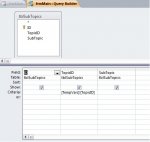What I want to do is have dependent combo boxes in a form that enters information back into a table. For instance, I have a Log form that enters records into the log table. I have two combo boxes, Topic and Sub-Topic. I would like the Sub-Topic combo box to be dependent upon the choice entered in the Topic Combo Box.
The trouble I'm seeming to have is I believe these have to be bound fields (to input back to the table). The examples I'm seeing are using unbound fields.
Is there something I'm missing?
ps. I'd like to do this without any VBA....I want to learn what is capable of a Web Database.
Thanks in advance for any help.
The trouble I'm seeming to have is I believe these have to be bound fields (to input back to the table). The examples I'm seeing are using unbound fields.
Is there something I'm missing?
ps. I'd like to do this without any VBA....I want to learn what is capable of a Web Database.
Thanks in advance for any help.

